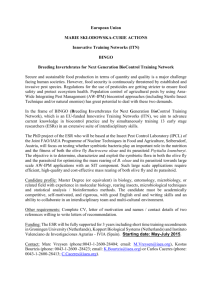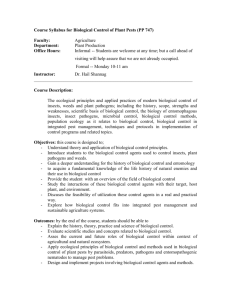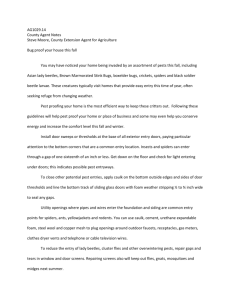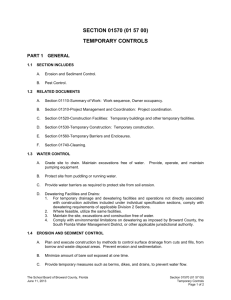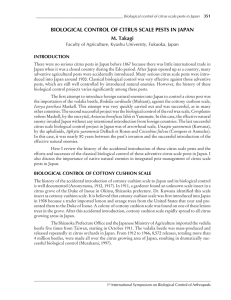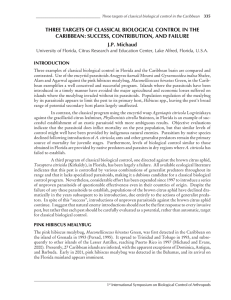W2185 renewal Appendix C Impacts
advertisement
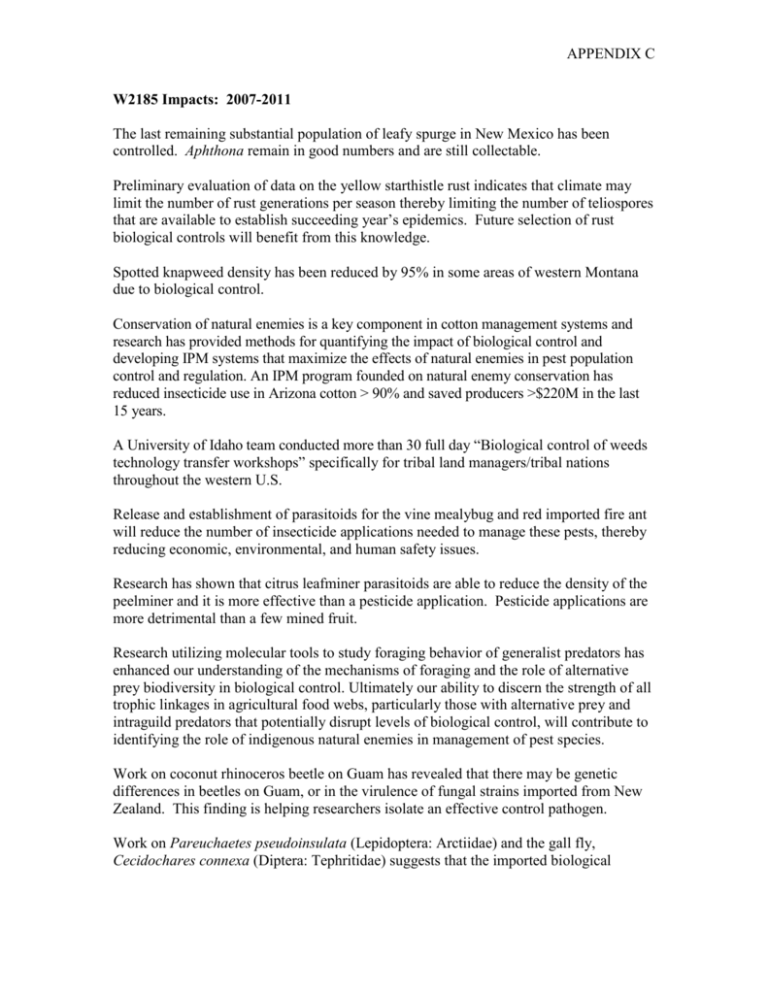
APPENDIX C W2185 Impacts: 2007-2011 The last remaining substantial population of leafy spurge in New Mexico has been controlled. Aphthona remain in good numbers and are still collectable. Preliminary evaluation of data on the yellow starthistle rust indicates that climate may limit the number of rust generations per season thereby limiting the number of teliospores that are available to establish succeeding year’s epidemics. Future selection of rust biological controls will benefit from this knowledge. Spotted knapweed density has been reduced by 95% in some areas of western Montana due to biological control. Conservation of natural enemies is a key component in cotton management systems and research has provided methods for quantifying the impact of biological control and developing IPM systems that maximize the effects of natural enemies in pest population control and regulation. An IPM program founded on natural enemy conservation has reduced insecticide use in Arizona cotton > 90% and saved producers >$220M in the last 15 years. A University of Idaho team conducted more than 30 full day “Biological control of weeds technology transfer workshops” specifically for tribal land managers/tribal nations throughout the western U.S. Release and establishment of parasitoids for the vine mealybug and red imported fire ant will reduce the number of insecticide applications needed to manage these pests, thereby reducing economic, environmental, and human safety issues. Research has shown that citrus leafminer parasitoids are able to reduce the density of the peelminer and it is more effective than a pesticide application. Pesticide applications are more detrimental than a few mined fruit. Research utilizing molecular tools to study foraging behavior of generalist predators has enhanced our understanding of the mechanisms of foraging and the role of alternative prey biodiversity in biological control. Ultimately our ability to discern the strength of all trophic linkages in agricultural food webs, particularly those with alternative prey and intraguild predators that potentially disrupt levels of biological control, will contribute to identifying the role of indigenous natural enemies in management of pest species. Work on coconut rhinoceros beetle on Guam has revealed that there may be genetic differences in beetles on Guam, or in the virulence of fungal strains imported from New Zealand. This finding is helping researchers isolate an effective control pathogen. Work on Pareuchaetes pseudoinsulata (Lepidoptera: Arctiidae) and the gall fly, Cecidochares connexa (Diptera: Tephritidae) suggests that the imported biological APPENDIX C control agent may be suppressing reproduction and growth in Chromolaena odorata on Guam and elsewhere in Micronesia. Ongoing ant surveillance surveys indicate that Lepisiota fraunfeldii populations at the Guam international airport have likely been eradicated. The 2 coccinellid species introduced to the Manu’a Islands to control Icerya seychellarum have continued to provide near complete control of this pest on breadfruits, safeguarding a traditional staple food crop and an important tree component of the village landscape. For the Diaprepes root weevil and the citrus leafminer, the natural enemies (introduced and native) will play an important role in managing both pests. For citrus leafminer, the potential exists for the natural enemies to lower densities of this pest to levels acceptable to growers. Results suggest that hedgerows, which are designed to enhance pollinators, and predators and parasites of pests, do not exacerbate stink-bug pests of processing tomato. Work on saltcedar (Tamarix) biological control indicates that not all sites are suitable for insectary establishment, and that the best sites are characterized by more vigorous, but widely spaced trees. This will aid in the selection of future Diorhabda release sites. Ultimately, reduced densities of tamarisk will provide enhanced habitat for native animals and plants and will provide for enhanced recreational experiences along Western rivers. Biological control projects have removed the need for insecticide applications on papaya, hibiscus and plumeria for control of papaya mealybug. Advances have been made in understanding how to conserve and measure the activity of native natural enemies of several major pests of cotton using life table and molecular techniques. Evaluation of the lethal and sublethal effects of insecticides and transgenic plants on key natural enemies through both field and laboratory studies is aiding the development of pest management strategies that minimize disruption of biological control. Methods continue to advance for using predator gut content ELISA and PCR assays to qualify the impact of indigenous predators. New molecular methods are being developed that will enable us to quantify the predation rates of an entire arthropod assemblage. The protein marking immunoassay provides a useful alternative to conventional marking techniques for mark-release-recapture and mark-capture studies. The technique is being used by researchers throughout the world to study various aspects of insect dispersal. The ecological benefit from biological control of Arundo donax to the Rio Grande Basin APPENDIX C and other areas impacted by this invasive weed could be enormous. Failure to control this invasive plant puts entire riparian ecosystems at risk. Biological control of A. donax will undoubtedly produce more social and political support for the continued restoration of the Rio Grande Basin and other parts of N. America. The direct economic benefit will be great since hundreds of millions of dollars are spent annually on chemical and cultural controls of A. donax. As ecosystems recover from reduction of A. donax, there should be a positive cascade effect throughout the food web of the riparian zones. Asian cycad scale appears to be under good biological control in many areas of Guam. Statistical analysis of Rhizobius lophanthae predation suggests that the beetle predation on A. yasumatsui does appear to be influenced by height above ground with scales on plants placed at 75cm and 150cm above ground about 38% more likely to be attacked than plants placed directly on the ground. Chalcidoidea are economically and biologically one of the most important groups of insects, and yet very little is known of their taxonomy (identification) or relationships. Research is identifying new potential biological control agents for use against pestiferous leafminers on citrus, whitefly on citrus, aphids on wheat and other crops, and for wasps attacking pestiferous ants. New research on cryptic species complexes (morphologically identical but reproductively and biologically distinct species) using molecular markers has tremendous potential for the identification of new biological control agents. Redistribution activities carried out in 2009 alone, have led to the enhancement of biological control agent distributions against 12 noxious weeds throughout Washington. Intensive deployment of Mecinus janthinus has retarded Dalmatian toadflax invasiveness, facilitated the restoration of many previously infested sites for animal foraging, and led to the re-establishment of desired native plant species. Landowner utilization of chemical and physical management methods has been diminished by 30% in WA because of the proliferation of biocontrol acceptance. Property owners/managers realized an estimated cost savings of $500K in 2009 through the implementation of weed biocontrol. Studies have demonstrated the inability of T. basalis to effectively suppress the stinkbug pest, Nezara viridula, in macadamia nut orchards, thus preventing growers from embarking on augmentative programs that would be uneconomical. Work has shown the benefits of combining cover-crops with corn to reduce pests and increase Trichogramma incidence. Because Hippodamia convergens serves as a keystone biological control agent of grain aphids in the Great Plains, knowing how larval and adult food influence development and fecundity may allow better predictions of synchrony of offspring with grain aphid pests in the spring and, thus, the degree of natural biological control that might be expected. Careful evaluation and consultation with local stakeholders will result in a better decision on the local appropriateness of a possible classical biological control effort against the erythrina gall wasp and greater support for such a project should it be initiated. APPENDIX C Adoption of recent biocontrol methods by New Jersey farmers will reduce pesticide use to control European corn borer and minimize exposure to pesticides the citizens of the state. Reduviidae have been called a neglected group of potential natural enemies among Heteroptera or True Bugs. Current studies, aiming on systematics and biology of Reduviidae, will provide a foundation for establishing assassin bugs as pest control agents. Data on distribution, biology, and relationships of native species are essential components for this foundation. A previously unknown parasitoid has been discovered that can be managed (locally) or exported (internationally) to contribute to control of a major aphid pest of bananas (Pentalonia nigronervosa). Results with the mite A. cucumeris on western flower thrips and tomato spotted wilt virus suggest that growers may be able to use biological control as an alternative to chemical control even on crops that are susceptible to virus infection. High numbers of the mass reared parasitoid wasps, Psyttalia concolor (Namibia) and P. lounsburyi (Kenya), by Israeli cooperators allowed for a good early season start of field releases in California. The first within-season recovery of P. concolor (Namibia) was made at a second site, most likely due to high numbers of this parasitoid released early in the olive growing season. Understanding the strengths and weaknesses of naturally occurring egg parasitoids against the light brown apple moth (LBAM) in its invaded range may be of considerable value in implementing an augmentative biological control program. It is suggested that inoculative releases in the spring may facilitate a more reliable occurrence of Trichogramma spp. to suppress LBAM populations in the spring, when the densities of this invasive pest undergo considerable increase. Several biological control options are being considered for the light brown apple moth in California. The option of augmentative releases of Trichogramma egg parasitoids (species naturally occurring in California) and foreign exploration for natural enemies in southern Australia will be investigated. In cooperation with UC Berkeley, pre-release monitoring of numerous potential release sites of light brown apple moth parasitoids (when permits become available) will be performed. Recovery of Peristenus relictus (=stygicus) for five consecutive years suggests permanent establishment of this beneficial organism in the Monterey Bay for the control of Lygus hesperus, the number one pest of strawberries in this region. A new population of P. relictus collected in Morocco should have a better chance at establishment in the southern San Joaquin Valley than earlier releases due to a better climatic match between this part of California and North Africa. APPENDIX C Biological control of the Erythrina gall wasp appears to have successfully prevented the extinction of the native tree, Erythrina sandwicensis, a keystone species in Hawaii’s few remaining threatened lowland forest ecosystems. Regional re-distribution of beneficial insects on rush skeletonweed, giant reed, Mediterranean sage, and purple loosestrife have been the first critical steps in the implementation of an area-wide biological control program against these noxious weeds. Landowner utilization of chemical and physical management methods has been diminished by >30% in WA because of the proliferation of biocontrol acceptance. The citrus leafminer has continued to spread throughout all of the citrus growing areas of California. Host specificity testing has started for Citrostichus phyllocnistis, a parasitoid of the citrus leafminer. If approved for release, this parasitoid would be used by growers and homeowners to reduce densities of citrus leafminer. Mecinus heydeni appears to be promising for biological control of yellow toadflax. Together with R. brondelii, M. laeviceps and Mecinus sp. n. from L. dalmatica ssp. macedonica could contribute to the control of Dalmatian toadflax. Documentation of establishment of the fly, J. ivannikovi populations has promoted interest in using the biological control agent by land-owners and weed managers. Established agents, such as Longitarsus jacobaeae, have significantly decreased tansy ragwort density by 75-97% at some sites in Montana. To further reduce reliance on pyrethroids in late-season peaches, enhancement of biological control of the Oriental Fruit Moth was initiated through habitat management by plantings of sunflowers along IPM blocks to provide overwintering and breeding habitat for a biological control agent.

